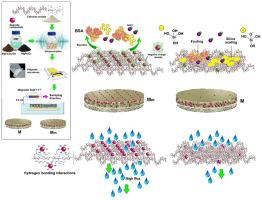利用具有有机/无机污垢控制能力的高通量诱导磁场羟基官能化 MgFe2O4 /CA 反渗透膜进行海水淡化的高效方法
IF 9
1区 工程技术
Q1 ENGINEERING, CHEMICAL
引用次数: 0
摘要
反渗透膜对水净化和海水淡化至关重要,面临着平衡渗透通量和排斥、处理膜污垢和抗氯性等挑战。本研究的重点是利用醋酸纤维素(CA)聚合物和磁性纳米颗粒(铁氧体镁(MgFe2O4)和羟基官能化铁氧体镁(OH-MgFe2O4)),通过相反转方法,在有磁场和无磁场的情况下开发新型膜,以解决反渗透膜的局限性。本研究进行了一项独特的实验,在 2.0 T 磁场的影响下,磁性纳米粒子迁移到膜表面,并在混凝槽中发生相变。结果,磁性纳米粒子以特定的模式排列并均匀地分布在膜表面,增强了膜的表面特性和亲水性能。此外,合成膜的通量在暴露于磁场时有所增加,同时保持了持续的高排斥率。对膜的抗牛血清白蛋白(BSA)有机污垢能力、抗结垢无机污垢能力以及抗牛血清白蛋白和结垢的综合影响能力进行了评估。根据研究结果,膜的防污性能明显增强,尤其是在暴露于磁场时。对标准膜和改进膜的抗氯性进行了评估。比较氯暴露前后膜的通量和排污量发现,两者的差异很小,这表明膜有能力抵御氯对表面的破坏。因此,通过创造创新的 MgFe2O4/CA 和 OH-MgFe2O4/CA 膜,反渗透膜的限制因素得到了有效解决。与 MgFe2O4/CA 膜相比,合成的反渗透膜之一--OH-MgFe2O4/CA 在渗透通量、排斥、防污和抗氯性方面表现出更优越的性能。此外,还通过拉伸强度测试评估了合成膜的稳定性,结果表明膜结构得以保留。本文章由计算机程序翻译,如有差异,请以英文原文为准。

An efficient approach in water desalination using high flux induced magnetic-field hydroxyl-functionalized MgFe2O4 /CA RO membranes with organic/inorganic fouling control capability
Reverse osmosis (RO) membranes are crucial for water purification and desalination, facing challenges like balancing permeate flux and rejection, dealing with membrane fouling, and chlorine resistance. This study focuses on developing new membranes using cellulose acetate (CA) polymers and magnetic nanoparticles of magnesium ferrite (MgFe2O4) and hydroxyl-functionalized magnesium ferrite (OH–MgFe2O4) through a phase inversion method, with and without the presence of a magnetic field, to address the limitations of RO membranes. This study conducted a unique experiment where magnetic nanoparticles migrated to the membrane surface and underwent phase exchange in the coagulation bath under the influence of a 2.0 T magnetic field. As a result, the magnetic nanoparticles were arranged in a specific pattern and evenly spread across the membrane surface, enhancing the membrane's surface characteristics and hydrophilic properties. Furthermore, the flux of the synthesized membranes experienced an increase when exposed to the magnetic field, while maintaining a consistently high rejection rate. An evaluation was conducted on the membranes' resistance to organic fouling from bovine serum albumin (BSA), inorganic fouling from scaling, and the combined effects of BSA and scaling. Based on the findings, the membranes showed a notable enhancement in their anti-fouling properties, particularly when exposed to a magnetic field. An assessment was conducted on the resistance to chlorine for both the standard and improved membranes. Comparing the flux and rejection of the membranes before and after chlorine exposure revealed a minor variation, suggesting the membrane's ability to resist surface damage from chlorine. Hence, through the creation of innovative MgFe2O4/CA and OH–MgFe2O4/CA membranes, the identified constraints of RO membranes were effectively addressed. One of the synthesized RO membranes, OH–MgFe2O4/CA, demonstrated superior performance in permeate flux, rejection, anti-fouling, and chlorine resistance when compared to MgFe2O4/CA membranes. Furthermore, the stability of the synthesized membranes was assessed through tensile strength testing, which confirmed the preservation of the membrane structure.
求助全文
通过发布文献求助,成功后即可免费获取论文全文。
去求助
来源期刊

Journal of Membrane Science
工程技术-高分子科学
CiteScore
17.10
自引率
17.90%
发文量
1031
审稿时长
2.5 months
期刊介绍:
The Journal of Membrane Science is a publication that focuses on membrane systems and is aimed at academic and industrial chemists, chemical engineers, materials scientists, and membranologists. It publishes original research and reviews on various aspects of membrane transport, membrane formation/structure, fouling, module/process design, and processes/applications. The journal primarily focuses on the structure, function, and performance of non-biological membranes but also includes papers that relate to biological membranes. The Journal of Membrane Science publishes Full Text Papers, State-of-the-Art Reviews, Letters to the Editor, and Perspectives.
 求助内容:
求助内容: 应助结果提醒方式:
应助结果提醒方式:


